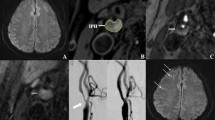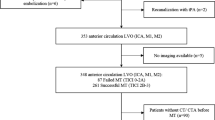Abstract
Introduction
Filling defects at the internal carotid artery (ICA) origin in the work-up of stroke or transient ischemic attack may be an ulcerated plaque or free-floating thrombus (FFT). This may be challenging to distinguish, as they can appear morphologically similar. This is an important distinction as FFT can potentially embolize distally, and its management differs. We describe a series of patients with suspected FFT and evaluate its imaging appearance, clinical features, and evolution with therapy.
Methods
Between 2008 and 2013, we prospectively collected consecutive patients with proximal ICA filling defects in the axial plane surrounded by contrast on CT/MR angiography. We defined FFT as a filling defect that resolved on follow-up imaging. We assessed the cranial–caudal dimension of the filling defect and receiver operating characteristics to identify clinical and radiological variables that distinguished FFT from complex ulcerated plaque.
Results
Intraluminal filling defects were identified in 32 patients. Filling defects and resolved or decreased in 25 patients (78 %) and felt to be FFT; there was no change in 7 (22 %). Resolved defects and those that decreased in size extended more cranially than those that remained unchanged: 7.3 mm (4.2–15.9) versus 3.1 mm (2.7–3.7; p = 0.0038). Receiver operating characteristic analysis established a threshold of 3.8 mm (filling defect length), sensitivity of 88 %, specificity of 86 %, and area under the curve of 0.86 (p < 0.0001) for distinguishing FFT from plaque.
Conclusion
Filling defects in the proximal ICA extending cranially >3.8 mm were more likely to be FFT than complex ulcerated plaque. Further studies evaluating filling defect length as a predictor for FFT are warranted.



Similar content being viewed by others
References
Bhatti AF, Leon LR Jr, Labropoulos N, Rubinas TL, Rodriguez H, Kalman PG et al (2007) Free-floating thrombus of the carotid artery: literature review and case reports. J Vasc Surg 45:199–205
Combe J, Poinsard P, Besancenot J, Camelot G, Cattin F, Bonneville JF et al (1990) Free-floating thrombus of the extracranial internal carotid artery. Ann Vasc Surg 4:558–562
Caplan L, Stein R, Patel D, Amico L, Cashman N, Gewertz B (1984) Intraluminal clot of the carotid artery detected radiographically. Neurology 34:1175–1181
Devuyst G, de Bray JM, Despland PA, Maeder P, Meuli R, Uské A et al (2000) Focal adherent thrombus in the common carotid artery: clinical, ultrasonographic, and pathogenic aspects in two cases. J Ultrasound Med 19:707–711
Menon BK, Singh J, Al-Khataami A, Demchuk AM, Goyal M (2010) The donut sign on CT angiography: an indicator of reversible intraluminal carotid thrombus? Neuroradiology 52:1055–1056
Latchaw RE, Alberts MJ, Lev MH, Connors JJ, Harbaugh RE, Higashida RT et al (2009) Recommendations for imaging of acute ischemic stroke: a scientific statement from the American Heart Association. Stroke 40:3646–3678
Jaberi A, Lum C, Stefanski P, Thornhill RE, Dowlatshahi D (2012) Computed tomography angiography evaluation of internal carotid artery free-floating thrombus-single-center diagnosis, false-positives, and follow-up. Emerg Radiol 19:359–362
de Weert TT, Cretier S, Groen HC, Homburg P, Cakir H, Wentzel JJ et al (2009) Atherosclerotic plaque surface morphology in the carotid bifurcation assessed with multidetector computed tomography angiography. Stroke 40:1334–1340
Buchan A, Gates P, Pelz D, Barnett HJ (1988) Intraluminal thrombus in the cerebral circulation. Implications for surgical management. Stroke 19:681–687
Saba L, Caddeo G, Sanfilippo R, Montisci R, Mallarini G (2007) Efficacy and sensitivity of axial scans and different reconstruction methods in the study of the ulcerated carotid plaque using multidetector-row CT angiography: comparison with surgical results. AJNR Am J Neuroradiol 28:716–723
Lovett JK, Gallagher PJ, Hands LJ, Walton J, Rothwell PM (2004) Histological correlates of carotid plaque surface morphology on lumen contrast imaging. Circulation 110:2190–2197
North American Symptomatic Carotid Endarterectomy Trial Collaborators (1991) Beneficial effect of carotid endarterectomy in symptomatic patients with high-grade carotid stenosis. N Engl J Med 325:445–453
Bartlett ES, Walters TD, Symons SP, Fox AJ (2006) Quantification of carotid stenosis on CT angiography. AJNR Am J Neuroradiol 27:13–19
Chan JL, Lee TH, Chen ST, Ryu SJ (1992) Recurrent stroke onset precipitated during carotid ultrasound examination in a case of severe internal carotid artery stenosis with soft, moving plaques. Recent Adv Neuros 441–3
Vellimana AK, Kadkhodayan Y, Rich KM, Cross DT 3rd, Moran CJ, Zazulia AR et al (2013) Symptomatic patients with intraluminal carotid artery thrombus: outcome with a strategy of initial anticoagulation. J Neurosurg 118:34–41
Biller J, Adams HP, Boarini D, Godersky JC, Smoker WR, Kongable G (1986) Intraluminal clot of the carotid artery. A clinical-angiographic correlation of nine patients and literature review. Surg Neurol 25:467–477
Nederkoorn PJ, van der Graaf Y, Eikelboom BC, van der Lugt A, Bartels LW, Mali WP (2002) Time-of-flight MR angiography of carotid artery stenosis: does a flow void represent severe stenosis? AJNR Am J Neuroradiol 23:1779–1784
Chirumamilla AP, Maehara A, Mintz GS, Mehran R, Kanwal S, Weisz G et al (2012) High platelet reactivity on clopidogrel therapy correlates with increased coronary atherosclerosis and calcification: a volumetric intravascular ultrasound study. JACC Cardiovasc Imaging 5:540–549
González A, Mayol A, Gil-Peralta A, González-Marcos JR, Boza F, Ruano J (2004) Angioplasty of symptomatic high-grade internal carotid artery stenosis with intraluminal thrombus: therapeutic approach. Neuroradiology 46:313–317
Chakhtoura EY, Goldstein JE, Hobson RW (2003) Management of mobile floating carotid plaque using carotid artery stenting. J Endovasc Ther 10:653–656
Barnett HJ, Meldrum HE, Eliasziw M (2002) The appropriate use of carotid endarterectomy. CMAJ 166:1169–1179
van Gils MJ, Homburg PJ, Rozie S, de Weert TT, Dippel DWJ, van der Lugt A (2011) Evolution of atherosclerotic carotid plaque morphology: do ulcerated plaques heal? A serial multidetector ct angiography study. Cerebrovasc Dis 31:263–270
Acknowledgments
DD is supported by a Clinician-Scientist Award from the Heart and Stroke Foundation, Ontario provincial branch.
Conflict of interest
We declare that we have no conflict of interest.
Author information
Authors and Affiliations
Corresponding author
Rights and permissions
About this article
Cite this article
Jaberi, A., Lum, C., Stefanski, P. et al. Computed tomography angiography intraluminal filling defect is predictive of internal carotid artery free-floating thrombus. Neuroradiology 56, 15–23 (2014). https://doi.org/10.1007/s00234-013-1298-7
Received:
Accepted:
Published:
Issue Date:
DOI: https://doi.org/10.1007/s00234-013-1298-7




